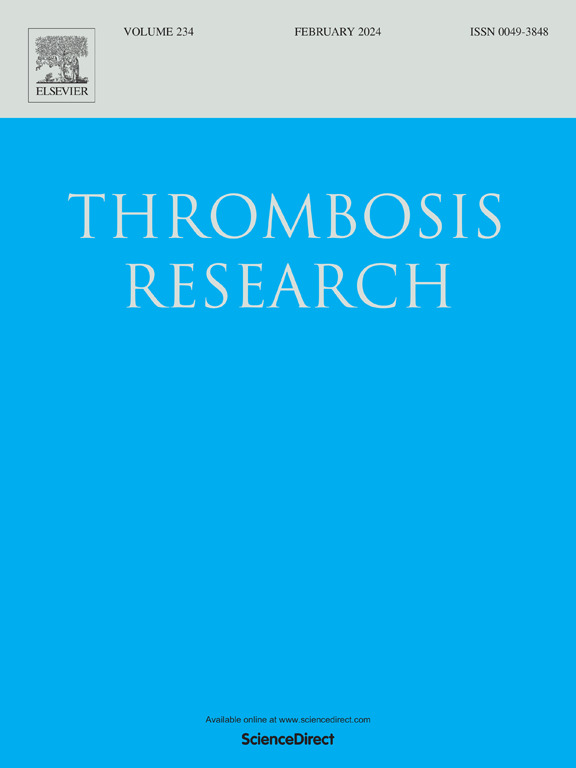Viscoelastic testing in patients with very rare bleeding disorders of secondary hemostasis, a scoping review
IF 3.4
3区 医学
Q1 HEMATOLOGY
引用次数: 0
Abstract
Introduction
Very rare bleeding disorders (VRBDs) are hereditary disorders which cause increased risk of bleeding. In general, VRBDs consists of rare platelet function disorders, very rare coagulation factor deficiencies (other than Factor (F) VIII or FIX) and disorders of the fibrinolytic pathway. The rarity of these disorders along with the scarcity of specialized hemostasis laboratories capable to perform the necessary diagnostic tests, results in significant challenges in diagnosing and monitoring patients with VRBD. Viscoelastic testing could potentially address these challenges.
Aim
This scoping review aims to assess the validity of viscoelastic assays for diagnosing, monitoring, and risk prediction in patients with VRBDs in the secondary hemostasis.
Methods
Relevant studies were identified on PubMed and categorized based on the clinical scenario addressed in the study.
Results
Viscoelastic assays can consistently detect severe factor deficiencies, but the sensitivity is lower in patients with mild factor deficiencies. In addition to the residual factor activity, sensitivity depends on the specific viscoelastic assay used and the potential underlying genetic abnormality. Only in FXI deficiency, multiple reports reveal correlations between assay outcomes and clinical phenotype, though clinical benefit of these findings is limited by the mild strength of these correlations. In many studies, viscoelastic assays were able to monitor the effects of treatment, but just a few found associations between the assay results and risk prediction.
Conclusion
Severe coagulation factor deficiencies can reliably be ruled out based on viscoelastic assays. Low-quality evidence showed benefit of these assays in monitoring treatment and risk prediction in VRBDs.
粘弹性测试在非常罕见的继发性止血出血性疾病的患者,一个范围审查
非常罕见出血性疾病(vrbd)是一种遗传性疾病,可导致出血风险增加。一般来说,vrbd包括罕见的血小板功能障碍,非常罕见的凝血因子缺乏(除了因子(F) VIII或FIX)和纤溶途径障碍。这些疾病的罕见性以及能够进行必要诊断测试的专门止血实验室的缺乏,给VRBD患者的诊断和监测带来了重大挑战。粘弹性测试可以潜在地解决这些挑战。目的本综述旨在评估粘弹性试验在vrbd患者继发性止血中的诊断、监测和风险预测的有效性。方法在PubMed上检索相关研究,并根据研究涉及的临床情况进行分类。结果粘弹性试验对重度因子缺乏症患者的敏感性较低,对轻度因子缺乏症患者的敏感性较低。除了残留因子活性外,敏感性取决于所使用的特定粘弹性测定和潜在的潜在遗传异常。只有在FXI缺乏症中,多个报告揭示了检测结果与临床表型之间的相关性,尽管这些发现的临床益处受到这些相关性的轻微强度的限制。在许多研究中,粘弹性测定法能够监测治疗效果,但只有少数发现测定结果与风险预测之间存在关联。结论粘弹性试验可可靠地排除严重凝血因子缺乏。低质量证据表明,这些检测在vrbd的监测治疗和风险预测方面有益处。
本文章由计算机程序翻译,如有差异,请以英文原文为准。
求助全文
约1分钟内获得全文
求助全文
来源期刊

Thrombosis research
医学-外周血管病
CiteScore
14.60
自引率
4.00%
发文量
364
审稿时长
31 days
期刊介绍:
Thrombosis Research is an international journal dedicated to the swift dissemination of new information on thrombosis, hemostasis, and vascular biology, aimed at advancing both science and clinical care. The journal publishes peer-reviewed original research, reviews, editorials, opinions, and critiques, covering both basic and clinical studies. Priority is given to research that promises novel approaches in the diagnosis, therapy, prognosis, and prevention of thrombotic and hemorrhagic diseases.
 求助内容:
求助内容: 应助结果提醒方式:
应助结果提醒方式:


